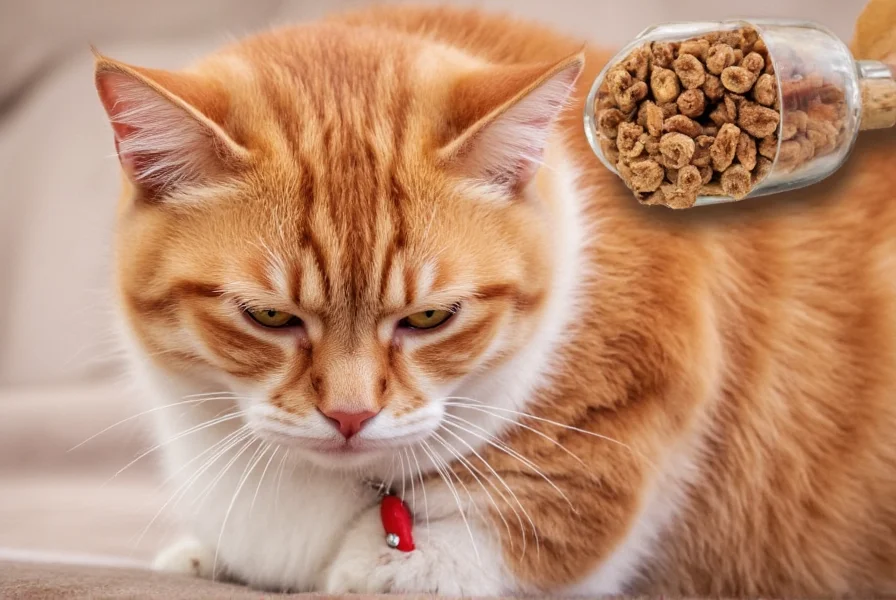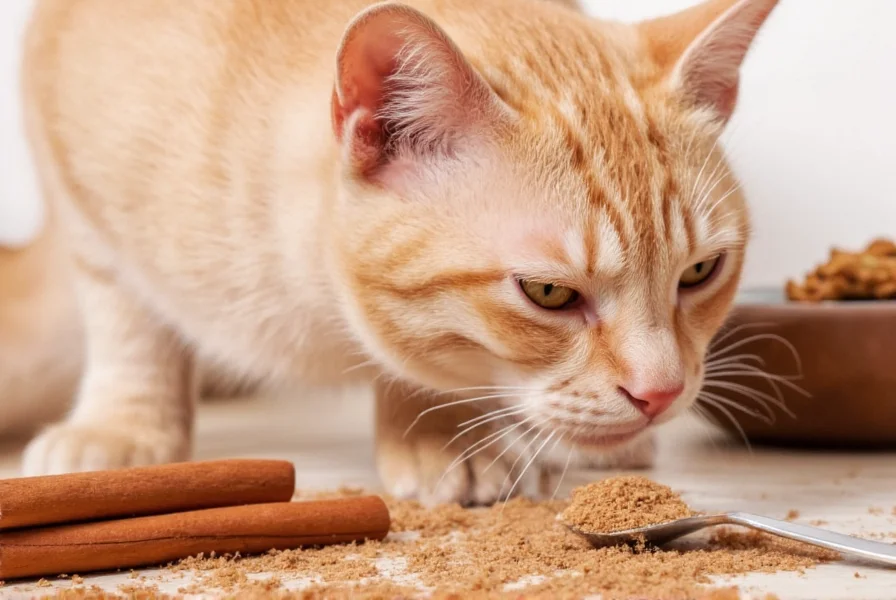As a pet owner, understanding household hazards is crucial for your cat's safety. Cinnamon, a common kitchen spice, presents several risks that many cat owners don't recognize. This comprehensive guide examines the specific dangers cinnamon poses to felines, helping you create a safer environment for your beloved companion.
Why Cinnamon Poses Risks to Cats
Cats process compounds differently than humans, making seemingly harmless substances potentially dangerous. Cinnamon contains several components that affect cats adversely:
- Coumarin - This compound can cause liver damage in cats, especially with repeated exposure
- Cinnamaldehyde - The primary component responsible for cinnamon's flavor and aroma can irritate mucous membranes
- Essential oils - Highly concentrated forms are particularly hazardous, even in small amounts
Unlike humans, cats lack certain liver enzymes needed to metabolize these compounds effectively. This biological difference means substances safe for us can become toxic to our feline friends.

Different Forms of Cinnamon and Their Risks
Not all cinnamon products pose equal threats. Understanding these differences helps assess potential danger levels:
| Cinnamon Form | Risk Level | Primary Concerns |
|---|---|---|
| Ground cinnamon | Moderate | Gastrointestinal upset, potential respiratory irritation if inhaled |
| Cinnamon sticks | Low to Moderate | Choking hazard, mild gastrointestinal issues if chewed |
| Cinnamon essential oil | Severe | Skin irritation, liver damage, respiratory distress, neurological symptoms |
| Cinnamon-scented products | Variable | Depends on concentration; air fresheners often contain dangerous levels |
Symptoms of Cinnamon Exposure in Cats
Recognizing early signs of cinnamon toxicity can make a critical difference in your cat's recovery. Symptoms typically appear within 2-12 hours after exposure and may include:
- Excessive drooling or pawing at mouth
- Vomiting and diarrhea
- Difficulty breathing or wheezing
- Lethargy or unusual weakness
- Low blood sugar (hypoglycemia) causing trembling or seizures
- Redness or irritation on skin that contacted cinnamon
- In severe cases, liver failure symptoms like jaundice
Many cat owners searching for symptoms of cinnamon poisoning in cats notice these signs after accidental exposure. The severity depends on the amount ingested and the form of cinnamon involved.
What Amount of Cinnamon Is Dangerous?
Unlike dogs, cats have no established safe consumption level for cinnamon. However, risk increases with quantity:
- Trace amounts (less than 1/8 teaspoon): Usually causes no symptoms, though sensitive cats might experience mild stomach upset
- Moderate exposure (1/4-1/2 teaspoon): Likely to cause vomiting, diarrhea, and oral irritation
- Significant exposure (more than 1/2 teaspoon): Risk of more severe symptoms including liver damage
- Essential oil exposure: Even 1-2 drops can cause serious toxicity
When cat owners search how much cinnamon is toxic to cats, they're often trying to assess an immediate situation. Remember that individual sensitivity varies, so any concerning exposure warrants veterinary consultation.
Immediate Actions for Cinnamon Exposure
If you discover your cat has accessed cinnamon, follow these steps:
- Remove any remaining cinnamon from your cat's reach
- Gently wipe your cat's mouth with a damp cloth to remove residue
- Check for cinnamon on paws or fur that could be ingested during grooming
- Contact your veterinarian or pet poison control immediately
- Do NOT induce vomiting unless specifically instructed by a professional
- Have the cinnamon product packaging available for reference
Many worried owners searching what to do if cat eats cinnamon need clear, immediate guidance. Your veterinarian may recommend observation for mild exposures or treatment for more significant incidents.
Preventing Cinnamon Exposure
Proactive measures protect your cat from accidental exposure:
- Store spices securely in closed cabinets cats cannot access
- Avoid using cinnamon-scented air fresheners or diffusers in your home
- Be cautious with baked goods containing cinnamon during preparation
- Keep essential oils completely out of reach - these pose the greatest danger
- Supervise your cat in kitchens where spices are used
Safe Alternatives for Cat-Friendly Homes
If you're looking for natural scents or remedies that won't harm your cat, consider these safer options:
- Fresh herbs like catnip, valerian root, or silver vine (specifically for cats)
- Lavender in small amounts (though some cats may still react)
- Unscented natural cleaning products
- Cat-safe plants like spider plants or wheatgrass
When researching safe spices to use around cats, remember that "natural" doesn't always mean safe for felines. Always verify pet safety before introducing new substances to your home environment.
When to Seek Veterinary Care
Contact your veterinarian immediately if your cat shows any of these symptoms after potential cinnamon exposure:
- Difficulty breathing or wheezing
- Repeated vomiting or diarrhea
- Signs of neurological distress (tremors, seizures)
- Extreme lethargy or unresponsiveness
- Any exposure to cinnamon essential oil
Even if symptoms seem mild initially, cinnamon toxicity can progress. Early intervention significantly improves outcomes when dealing with cinnamon exposure treatment for cats.
Final Considerations for Cat Owners
While cinnamon isn't among the most toxic household substances, it presents real risks to cats that many owners overlook. The growing popularity of essential oils and natural remedies has increased exposure risks in recent years. Understanding these dangers helps you make informed decisions about products in your home.
Remember that individual cats vary in their sensitivity. What causes mild symptoms in one cat might trigger severe reactions in another. When in doubt about potential exposure to cinnamon or other household substances, always consult your veterinarian for personalized advice.
Frequently Asked Questions
Is ground cinnamon toxic to cats in small amounts?
Small amounts of ground cinnamon (less than 1/8 teaspoon) typically cause only mild gastrointestinal upset in most cats, such as temporary vomiting or diarrhea. However, some cats may be more sensitive, and repeated exposure can lead to more serious issues like liver damage. While not immediately life-threatening in tiny quantities, it's best to prevent any exposure to ground cinnamon.
What should I do if my cat licked cinnamon essential oil?
Cinnamon essential oil requires immediate veterinary attention, even with minimal exposure. Essential oils are highly concentrated and can cause severe toxicity. Wipe any visible oil from your cat's mouth and fur with a damp cloth, then contact your veterinarian or pet poison control immediately. Do not wait for symptoms to appear, as essential oil toxicity can progress rapidly in cats.
Can cinnamon cause long-term damage to cats?
Yes, repeated or significant cinnamon exposure can cause long-term damage to cats, particularly to the liver. The coumarin in cinnamon is hepatotoxic, meaning it can damage liver tissue over time. Chronic exposure may lead to liver dysfunction that persists even after exposure stops. This is why preventing ongoing exposure to cinnamon and cinnamon-containing products is crucial for your cat's long-term health.
Are cinnamon-scented candles safe around cats?
Cinnamon-scented candles pose multiple risks to cats. The heat can release cinnamon compounds into the air that may irritate your cat's respiratory system. Additionally, if your cat knocks over a burning candle, they could suffer burns or ingest melted wax containing cinnamon. The safest approach is to avoid cinnamon-scented candles entirely and choose cat-safe alternatives if you want to use candles in your home.
How long do cinnamon poisoning symptoms last in cats?
Most mild symptoms from cinnamon exposure (like vomiting or diarrhea) typically resolve within 24-48 hours with proper care. However, more severe cases involving significant ingestion or essential oil exposure may require several days of veterinary treatment. Liver damage from chronic exposure can have longer-lasting effects that require ongoing monitoring and treatment. The duration depends on the amount ingested, the form of cinnamon, and how quickly treatment was initiated.











 浙公网安备
33010002000092号
浙公网安备
33010002000092号 浙B2-20120091-4
浙B2-20120091-4